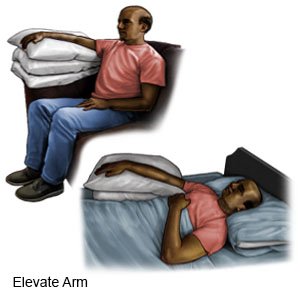Thumb Fracture
Medically reviewed by Drugs.com. Last updated on Aug 4, 2025.
AMBULATORY CARE:
A thumb fracture
is a break in a bone in your thumb.
 |
Common signs and symptoms:
- Pain and swelling
- Little or no thumb movement
- Thumb shape or position that is not normal
Seek care immediately if:
- Your cast cracks or breaks.
- You are not able to move your fingers.
- You have severe pain in your thumb or hand.
- You have new or increased swelling in your thumb or hand.
- Your cast feels too tight.
- Your injured thumb is numb.
- Your skin under the cast or splint burns or stings.
Call your doctor or hand specialist if:
- The skin around your cast becomes red and sore.
- The skin under your cast or splint itches, and the itch does not go away.
- You have questions or concerns about your condition or care.
Treatment
may include any of the following:
- Prescription pain medicine may be given. Ask your healthcare provider how to take this medicine safely. Some prescription pain medicines contain acetaminophen. Do not take other medicines that contain acetaminophen without talking to your healthcare provider. Too much acetaminophen may cause liver damage. Prescription pain medicine may cause constipation. Ask your healthcare provider how to prevent or treat constipation.
- A cast or splint will help keep your thumb in the correct position as it heals.
- Closed reduction is used to move the bones of your thumb back into their correct positions without surgery. Your healthcare provider will line your bones up by hand.
- Open reduction and internal fixation is surgery to straighten your broken bones. Wires, screws, metal plates, or pins may be used to hold your broken bones together.
Self-care:
- Apply ice on your thumb to help decrease swelling and pain. Ice may also help prevent tissue damage. Use an ice pack, or put crushed ice in a plastic bag. Cover it with a towel before you place it on your thumb, splint, or cast. Apply ice for 15 to 20 minutes every hour, or as directed.
- Elevate your thumb above the level of your heart as often as you can. This will help decrease swelling and pain. Prop your hand on pillows or blankets to keep your thumb elevated comfortably.

- Check the skin around your cast or splint daily for red or sore areas.
- Go to a hand therapist, if recommended. Your healthcare provider may recommend this after your cast or splint is removed. A hand therapist can help you with exercises to strengthen your hand and help restore movement.
Cast or splint care:
- Keep the cast or splint dry. Cover as directed when you need to shower.
- Do not stick objects inside to scratch an itch.
- Do not pull the padding out.
- Keep dirt, sand, and powder out.
Follow up with your doctor or hand specialist as directed:
You may need x-rays of your thumb to check the position as it heals. Your cast may need to be removed after 2 to 3 weeks to check any wounds. Write down your questions so you remember to ask them during your visits.
© Copyright Merative 2025 Information is for End User's use only and may not be sold, redistributed or otherwise used for commercial purposes.
The above information is an educational aid only. It is not intended as medical advice for individual conditions or treatments. Talk to your doctor, nurse or pharmacist before following any medical regimen to see if it is safe and effective for you.
Further information
Always consult your healthcare provider to ensure the information displayed on this page applies to your personal circumstances.
